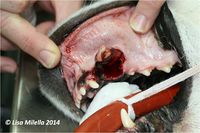Luxated and Avulsed Teeth
Introduction
Occasionally, veterinarians are presented with luxated or avulsed teeth.
Luxated = partly dislocated from the socket. The most common luxation is a lateral luxation together with fracture of the alveolar bone plate.
Avulsed = completely removed/pulled out of the socket
In these cases of trauma, the blood supply to the tooth is affected, resulting in pulp necrosis.
Injured teeth will require treatment - either extraction or replacement and stabilization, and once the tooth has re-attached, endodontic treatment will be required.
| Luxated and Avulsed Teeth Learning Resources | |
|---|---|
To reach the Vetstream content, please select |
Canis, Felis, Lapis or Equis |
| This article was written by Lisa Milella BVSc DipEVDC MRCVS. Date reviewed: 13 August 2014 |
| Endorsed by WALTHAM®, a leading authority in companion animal nutrition and wellbeing for over 50 years and the science institute for Mars Petcare. |
Error in widget FBRecommend: unable to write file /var/www/wikivet.net/extensions/Widgets/compiled_templates/wrt6932a8ae197194_14882701 Error in widget google+: unable to write file /var/www/wikivet.net/extensions/Widgets/compiled_templates/wrt6932a8ae4164c0_88396499 Error in widget TwitterTweet: unable to write file /var/www/wikivet.net/extensions/Widgets/compiled_templates/wrt6932a8ae612783_12309845
|
| WikiVet® Introduction - Help WikiVet - Report a Problem |
